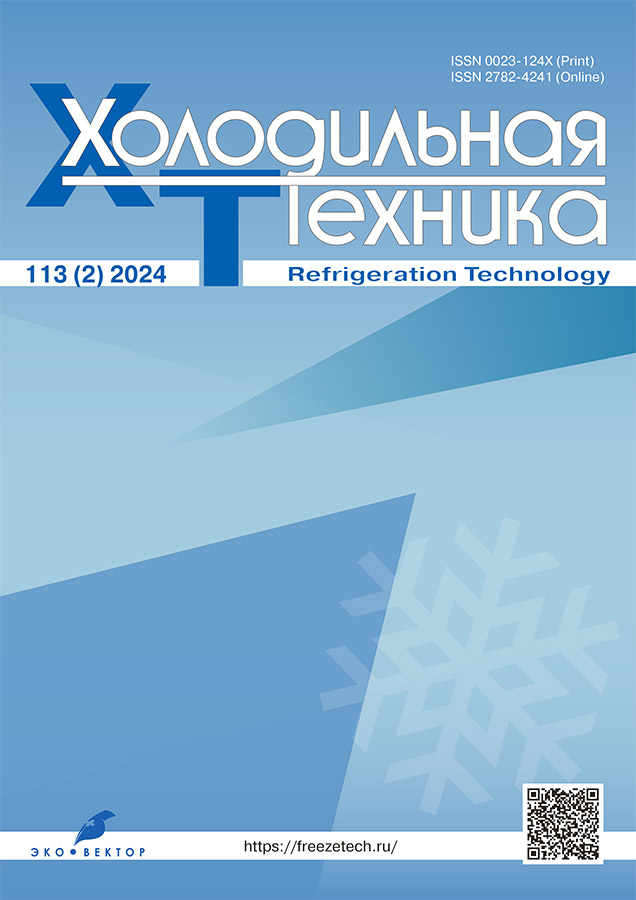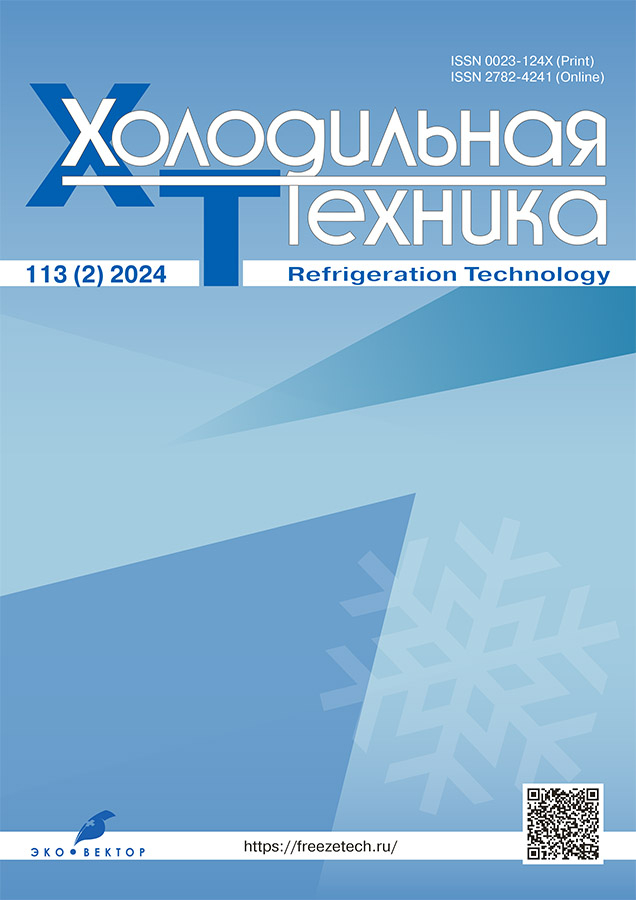Refrigeration Technology
Peer-review quarterly journal.
About
The journal publish fundamental and applied research and reviews also with informational and analytical articles on all areas of refrigeration, cryogenic engineering and technology, air conditioning and ventilation, automation and control, re-transport, food production processes and equipment, working substances, environmental problems and energy saving.
The journal is the primary source of information on fundamental and applied works of leading scientists.
Founder & Publisher
- Eco-Vector
WEB: https://eco-vector.com/
Editor-in-Chief
- Maxim S. Talyzin
ORCID: 0000-0001-7244-1946
Indexing
- Russian Science Citation Index
- Agris
- Google Scholar
- WorldCat
- Ulrich's Periodicals Directory
APC, Publication & Distribution
- Articles in English and Russian
- quarterly issues
- continuously publication online in Online First
- Hybrid Access (Subscription or Open Access with CC BY-NC-ND 4.0 License)
- No Article Processing Charges and/or Article Publication Charges (APC)
Types of accepted articles
- reviews
- systematic reviews and metaanalyses
- original research
- letters to the editor
- short communications
Current Issue
Vol 113, No 2 (2024)
Reviews
Technologies increasing the distillation performance
Abstract
Improving the energy efficiency of distillation columns widely used in various industries is the focus of many researchers. Although conventional state-of-the-art distillation columns are widely used and cost efficient, new technologies can significantly reduce operating costs, the overall cost of a distillation plant and are important for global sustainable development. This article reviews and compares technologies aimed at increasing the energy efficiency of distillation plants, including multi-effect distillation, thermally coupled distillation, and diabatic distillation. Multi-effect distillation allows increasing the number of separation stages, thereby increasing the process efficiency. In thermally coupled distillation, the number of required heat exchangers is reduced through direct contact of steam and liquid flows fed from different columns. In diabatic distillation, controlled heat exchange devices are used to approximate process conditions to phase equilibrium line of the system. The paper also describes some promising developments improving the design of distillation columns, including the dividing-wall column and distillation with intermediate heat exchangers. These technologies have their advantages and can be integrated in industrial processes under certain conditions. This article is aimed at reviewing and comparing the existing common solutions designed to increase the energy efficiency of distillation columns.
 54-61
54-61


Original Study Articles
Development of environmental control system for supersonic civil aircraft
Abstract
Background: Development of a new supersonic civil aircraft (SCA) requires a new environmental control system (ECS) to meet the improved fuel efficiency requirements to state-of-the-art passenger aircraft. It is proposed to increase energy efficiency to improve fuel efficiency of SCA by using electric compressors (EC) to compress air in the ECS.
Aim: This article aims at assessing the performance of the ECS configuration developed as a result of research and development (R&D) of the ECS for SCA.
Materials and methods: We developed a static mathematical model of the ECS for SCA with moisture content control to determine system parameters of the main expected operating modes.
Results: The article presents the basic parameters of the ECS for SCA and the calculation of ECS parameters for the main expected operating modes.
Conclusion: The article presents conclusions on the performance of the developed ECS design for SCA, the level of readiness of the developed ECS technology, the need for research and development of demonstrators of EC technologies and an ECS pack.
 63-75
63-75


Study of ammonia screw compressor used in a refrigeration unit a chiller with economizer
Abstract
Background: Energy conservation and reduction of negative environmental impact of refrigeration units are relevant when developing new equipment. In this regard, we study the development of an ammonia oil-filled screw compressor for a low-temperature refrigeration cycle with an economizer. Ammonia is a natural refrigerant not subject to the Montreal, Copenhagen, and Kyoto Protocols, and economizers allow to increase the refrigeration coefficient compared to a two-stage cycle.
Aim: To propose a method to calculate intermediate pressure at which a refrigeration cycle with an economizer will have the highest refrigeration coefficient.
Methods: The refrigeration coefficient is calculated analytically. For this purpose, we developed a plant diagram. For all studied modes, we developed cycles s in enthalpy-pressure diagrams and calculated the refrigeration capacity, power consumption, and the refrigeration coefficient.
Results: We determined the correlation of refrigeration coefficient with the intermediate pressure for all studied modes.
Conclusion: We developed a method to calculate intermediate pressure at which a a refrigeration cycle with an economizer has the highest performance.
 76-82
76-82


Comparative analysis of air condensers
Abstract
Background: The refrigeration industry continues to develop new technologies utilized in the daily operations of various businesses and plants. A clear example is the development of microchannel air heat exchangers. They are characterized by high energy efficiency, material savings and low refrigerant consumption. Despite all advantages, microchannel condensers have one major drawback — they are poorly known. Therefore, this paper studies these heat exchangers, including the experimental study of heat exchange parameters and comparative analysis of microchannel and tube plate air condensers.
Aim: To compare microchannel and tube plate condensers in relation to temperature gradient and thermodynamic efficiency of refrigeration units.
Methods: The problems are solved by an experimental study of microchannel and tube plate condensers in the laboratory, experimental data processing, measurement error assessment, and thermodynamic analysis of operating cycles of refrigeration units based on air condensers.
Results: We calculated the temperature gradient, subcooling temperatures of the studied heat exchangers, and refrigerating factors of the units.
Conclusion: The study shows that the difference between condensation and ambient temperatures in a microchannel condenser is smaller than in the tube plate heat exchanger. The microchannel refrigeration unit has a higher effective refrigerating factor.
 84-89
84-89


Entropy analysis in data center chiller operation
Abstract
Background: Refrigeration system s are widely used in various industries. To achieve temperatures below the ambient temperature and remove excess heat, it is required to expend work (power). Such expenses often constitute a significant portion of energy consumed by the entire facility.
For example, refrigeration equipment used in a most fast-growing industry, construction of data centers (DCs), consume up to 40% of the total power consumption [1].
To reduce energy consumption, it is important to analyze the operation at all life cycle stages from design to operation. Theoretical results often lag far behind practice and require changing both the refrigeration system design and its control algorithms.
This paper presents an analysis of a data center liquid refrigeration unit and the actions aimed at improving the system performance.
Aim: To demonstrate the requirement in and possible uses of operational analysis of refrigeration system at the commissioning stage.
Methods: Chiller losses in the data center refrigeration system were analyzed using the entropy-statistical thermodynamic analysis [2]. Based on the analysis, actions were taken to improve the chiller performance.
Results: Entropy-statistical thermodynamic analysis at life cycle stages of a refrigeration unit allows to identify components that require intervention (adjustment, replacement, etc.). Deviation of the effective refrigeration coefficient from the design value was 13.67% after commissioning and 4.14% after evaporator replacement. As the design specification of the refrigeration unit indicated that the refrigeration coefficient not be lower than 5.4, the achieved value of 5.34 with 1.04% deviation from the specification is acceptable.
Conclusion: Entropy-statistical thermodynamic analysis at the design and commissioning stages allow to achieve the specified performance values. In addition, the distribution of losses allowed to identify a component with the highest losses, which was then adjusted.
 90-96
90-96


Development of an energy efficient no-bleed environmental control system for aircraft with distributed power plant
Abstract
Background: Today, there are high fuel efficiency requirements to state-of-the-art passenger aircraft. The environmental control system (ECS), a one on general aircraft systems, shall have high energy efficiency to ensure the overall fuel efficiency of the aircraft, including by integrating compressed air sources and electric air cycle machines in the ECS.
Aim: To estimate the performance of the circuit solution created during research and development (R&D) of the energy-efficient electric ECS of an aircraft.
Materials and methods: We developed a static mathematical model of an electric ECS with moisture content control to determine system parameters in various operating modes.
Results: The article presents specifications of the electric turbo compressor (ETC) as a key unit of the studied electric ECS and the calculation of ECS parameters for different operating modes.
Conclusion: The article presents conclusions on the operability of the proposed design of an energy-efficient ECS with an ETC for a regional distributed propulsion aircraft, the achieved level of readiness of the ECS technology, the need for research and development of ETC and ETC-based ECS pack.
 97-105
97-105










